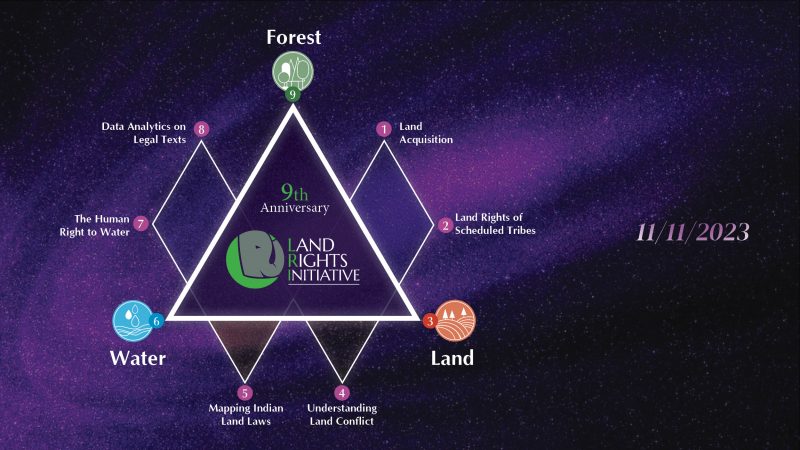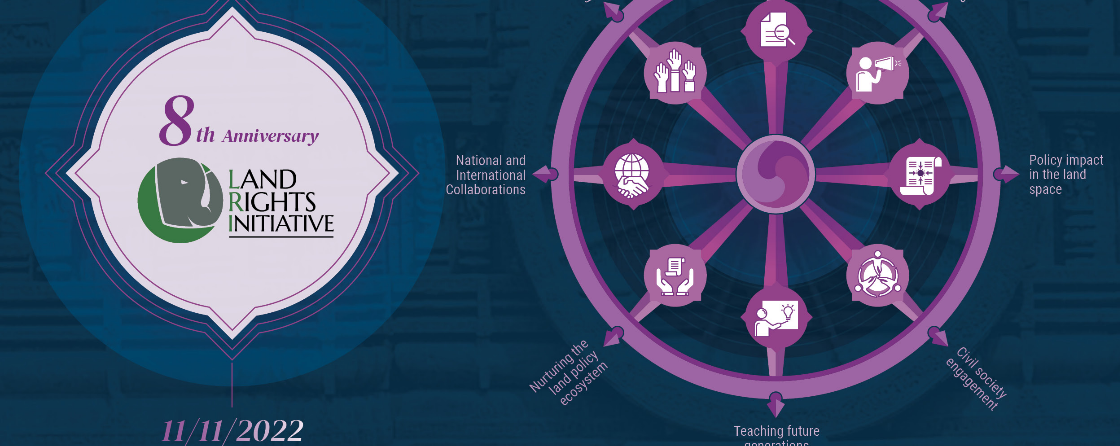Land Rights Initiative turns 9!
Namita Wahi
November 11, 2023

Land Rights Initiative (“LRI”) turns 9 today! We mark this important milestone at a time when the Centre for Policy Research, and the world at large are facing unprecedented existential questions. Climate devastation is upon us. Climate experts and the UN warn us that by 2050, due to the melting of the polar ice caps and rise in surface temperatures, we will have both extreme heat and flooding, which will cause over a billion people to become refugees in search of food, water, and shelter, and increase conflict over land. At the same time, digital technology opens up new horizons for human imagination and positive policy interventions in these challenging times.
Over the past nine years, LRI has built up a body of knowledge that has shifted policy narratives on land conflict, even if some of those shifts may have faced backlash from conservative forces within and outside government. LRI’s pioneering research reports on “Land Acquisition in India: A Review of Supreme Court Cases from 1950 to 2016” (2017), “The Legal Regime and Political Economy of Land Rights of Scheduled Tribes in Scheduled Areas of India” (2018) and policy brief on “Understanding Land Conflict in India” (2019) have illuminated the historical reasons for legal and extra-legal conflict over land. This conflict has arisen largely due to development projects, including large dams, mines, infrastructure, and urbanisation. During this time, LRI has also successfully used digital technology to transform an arcane, inaccessible subject involving conflicting “people versus state” narratives over land, encapsulated in a thousand colonial and post-colonial land related laws, into a readily accessible, exploratory archive of all land laws in India, a veritable “google maps for land laws”. This ongoing project titled “Mapping Indian Land Laws” is now available both in its web and mobile versions on landlawsofindia.org (2022).
The frequency and severity of extreme climatic events will exacerbate land conflict, which mandates us to inquire as to how we can use LRI’s existing knowledge base built over the past nine years in helping mitigate not just land conflict but climate related devastation? India’s strategy for mitigating climate devastation, as described in the government’s nationally determined contribution (“NDC”) pursuant to the UN Framework Convention on Climate Change, 1994, is focused primarily on investing in renewable or clean energy, energy conservation and efficiency, and planned afforestation. As per government estimates, 24% of India’s geographic area is under forest cover populated largely by Adivasi or forest dwelling communities. 11% of India’s population consists of Adivasis (8.6%) and other forest-dwelling communities (2.4%).
LRI’s research reports have shown that development induced displacement has affected Scheduled Tribes (“STs”) or Adivasis disproportionately. It is estimated that STs or Adivasis are only 8.6% of India’s population but constitute 40% of those displaced during the period from 1950 to 1999 due to dams, mines, wildlife parks and sanctuaries. Similarly, my journal article on “The Evolution of the Right to Water in India” (2021) has shown that while the articulation of a human right to water has been necessary to counter discrimination against Dalits in accessing sources of water, it has been used to justify the construction of dams and irrigation channels that have further displaced Adivasis.
Our life experience shows that whatever we seek to transform, transforms us. Over the past years of leading LRI’s work in helping the National Commission on Scheduled Tribes to empower ST or Adivasi communities, I have been educated and inspired by the Adivasi or indigenous imagination on “jal, jungle, zameen”, or “water, forest, and land”. Despite increasing recognition of the role of Adivasi or indigenous communities in protecting forests better than state-run forest departments in India and all over the world, both in the government’s “National Climate Mission”, and in its NDC, ST or Adivasi communities are conspicuous by their absence. This omission is an inexplicable tragedy for the global fight against climate devastation especially since the Adivasi or indigenous imagination encapsulated within the Forest Rights Act, 2006, provides a hopeful blueprint for mitigating climate effects through the protection and regeneration of forests.
In its recognition of individual and community rights over forestland including water bodies, the FRA encapsulates two important aspects of indigenous imagination. The first is that humans are not separate from the environment, and therefore no afforestation policy is workable without the active engagement of the communities that have been living in forests as their way of life for centuries. The second is that “jal, jungle, zameen” (“water, forest, and land”) are part of one indivisible ecosystem which is not just crucial to the Adivasi or indigenous way of life but for climate sustainability on planet earth.
As LRI enters its 10th year, even as we continue our ongoing work to shift the focus of development policy on land from its current “utilitarian” bent to a more “dignitarian” one, we hope also to transcend the limitations or silos of the “rights” framework towards a more holistic reimagination of policy frameworks pertaining to land, water, and forests. We believe that technological interventions like our ongoing “Data Analytics on Legal Texts” project, which involves an attempt to develop algorithms to speed up legal and social science research, provide us the roadmap for speeding up data driven research pertaining to law and land, which will help us in more effective reimagination of these integrated policy frameworks.
As always, we remain incredibly grateful to the Centre for Policy Research, our researchers, donors, mentors, collaborators, government, civil society groups, and communities that have made this journey possible and our work sustainable.
Dr. Namita Wahi,
Lead, Land Rights Initiative,
Senior Fellow, Centre for Policy Research



